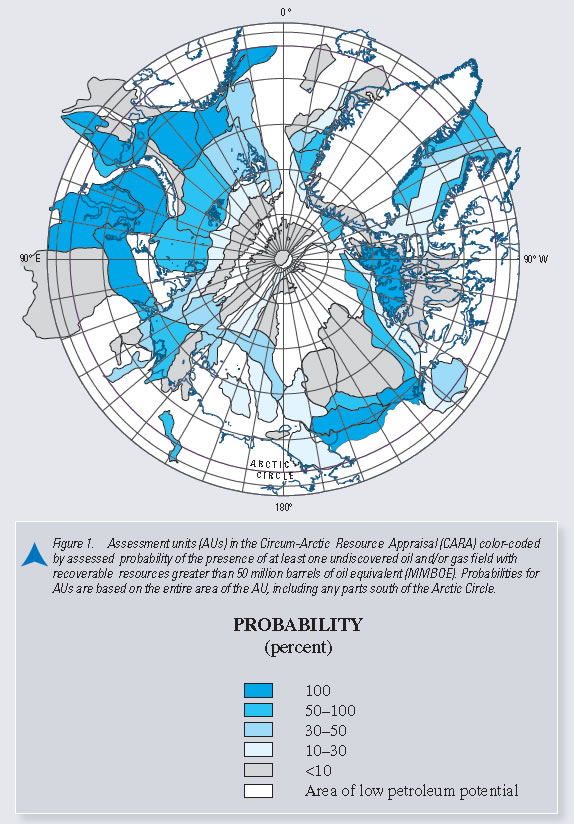

Natural gas in Arctic mostly Russian
Anchorage Daily News
May 28th, 2009
STUDY: By comparing geological conditions with other parts of the world, Alaska could fare well too.
Nearly one-third of the natural gas yet to be discovered in the world is north of the Arctic Circle and most of it is in Russian territory, according to a new analysis led by researchers at the U.S. Geological Survey. Alaska also is believed to hold a significant storehouse.
"These findings suggest that in the future the ... pre-eminence of Russian strategic control of gas resources in particular is likely to be accentuated and extended," said Donald L. Gautier, lead author of the study published in Friday's edition of the journal Science.
Russia is already the world's leading natural gas producer, noted Gautier, of the Geological Survey's office in Menlo Park, Calif.
The report, by an international scientific team, estimated that the Arctic also contains 3 percent to 4 percent of the world's oil resources remaining to be discovered.
Two-thirds of the undiscovered gas is in just four areas -- the South Kara Sea, North Barents Basin, South Barents Basin and the Alaska Platform -- the report said.
Indeed, the South Kara Sea off Siberia contains 39 percent of the Arctic's undiscovered gas, the researchers said.
The Alaska Platform extends from the central North Slope to offshore waters in the Beaufort and Chukchi seas. The report says this swath of Alaska offshore and onshore:
• Contains an estimated 8 percent of the Arctic gas, or an estimated 38 trillion cubic feet -- about as much as has been discovered in the Prudhoe Bay area.
• Contains more than 31 percent of the Arctic region's undiscovered oil, or an estimated 28 billion barrels -- not quite twice as much as has been produced from the North Slope since 1977.
The report shows that Alaska is "heads and shoulders over the other regions for undiscovered oil; but even on the gas side, we are in the top four," said Marilyn Crockett, executive director of the Alaska Oil and Gas Association, an industry group.
Oil companies have been pushing into frontier areas of Alaska's Arctic.
Onshore oil exploration has been stretching from the main cluster of North Slope oil fields west into the National Petroleum Reserve Alaska and south toward the Brooks Range.
Off Alaska's northern coast, at least two major oil companies -- Shell and Conoco Phillips -- have been eager to explore for offshore oil and gas but some of their efforts have been opposed by Native communities and environmentalists and blocked by courts for now.
WHO OWNS THE ARCTIC
Russia has been active in asserting its claim to parts of the Arctic. It first submitted a claim to the United Nations in 2001 but was rejected for lack of evidence. The United States, Canada, Denmark and Norway have also sought to assert jurisdiction over parts of the Arctic.
Now Russia is working to prove that an underwater mountain range crossing the polar region is part of its continental shelf. In 2007, two Russian civilian mini-submarines descended to the seabed to collect geological and water samples and drop a titanium canister containing the Russian flag.
Arctic oil reserves are much smaller than those of natural gas and are unlikely to lead to any shift in world oil balance, Gautier said in a recorded briefing provided by Science.
But they could be of importance locally if developed by individual countries, he said, citing in particular the United States and Greenland, which is governed by Denmark.
"New discoveries (off Alaska's coast) could maintain the flow of Alaskan oil for many years to come," according to the report.
However, Gautier added, the study looked only at the geological setting and the chance that energy resources are present.
"If these resources were to be found they would not be found all at once; they would be found incrementally and they would be produced incrementally," he said, urging caution about assuming that the oil might extend world production significantly.
MANY UNKNOWNS
Conservationists have advocated against drilling in the Arctic, citing possible environmental damage and concerns about continued reliance on fossil fuels that are linked to global warming. Native groups in Alaska have challenged how well the federal government has assessed the potential damage to their whaling and other subsistence food gathering if oil development happens in federal Arctic waters.
Gautier said the study focused on geological conditions in the Arctic and how they compared to other parts of the world where oil and gas have been found.
Because so much of this territory is unexplored and data are so limited, the researchers had to develop a new method to do assessments, Gautier said.
They collected the best information they could for the region and then subdivided it into geological areas. Those areas were compared with other geological regions around the world where gas or oil have been found in order to produce their assessment of where more resources are likely to be located.
Gas and oil tend to be found in sedimentary basins, he said, and "each one of these basins has a story, a geologic story."
"As new data become available our understanding of the resources in the Arctic will change," he added.
Circum-Arctic Resource Appraisal: Estimates of
Undiscovered Oil and Gas North of the Arctic Circle
Donald L. Gautier (CARA Project Chief) et al, US Geological Survey
 |
Posted by Arthur Caldicott on 30 May 2009